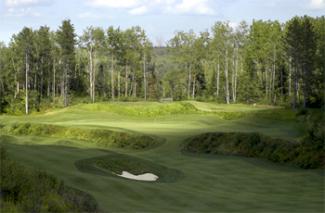Featured Golf News
Using Fairway Slopes for Strategy
We often ignore slope as a hazard, perhaps because we plan so many golf courses on flat pieces of paper on the drafting board, and partly because, at the highest levels, golf is such an aerial game.

The 13th Hole at the Quarry at Giant's Ridge
Offers Multiple Lies & Slopes
Whether a fairway has hazards or not, slopes can play an integral part in how the tee shot is played. Some typical ways to use contour to enhance a hole include:
• Steep Cross-Slopes - While many fairways are gently concave (sloping into the middle) or have containment mounding to help hold in shots, this is a relatively new idea in course design. Older courses tended to fit the land, which might have featured a strong cross-slope either left or right, forcing golfers to aim at the high side of the fairway to keep the shot from rolling to the low-side rough. When fairways were cut higher, this could mean cross-slopes of 10 percent or a bit more. That is still possible on "stickier" bluegrass and Zoysia fairways, providing the landing zone slopes uphill to kill momentum. On bent or Bermuda fairways, maximum cross-slope is probably 7 percent on level zones, and 4-5 percent if the fairway also slopes downhill, furthering roll.
• Random Contours - Older courses tended to fit the land, which often meant rolls, hillocks and slopes on a smaller scale. While the tee shot might not roll off the fairway, it might roll to a low area or find a hanging lie on a side-slope. While randomness doesn't necessarily add strategy, it does make for different and more interesting approach shots!
• Strategic Rolling Contours - In many cases, architects have built "random contours," often at the 290-plus-yard area of the landing zone, where the cost of bunkers to provide more challenge to the 1 percent of the long hitters is too high. Leaving shorter landing zones flat for average players, but sloping landing areas for long tee shots, tends to equalize the challenges for each level of golfer.
• Plateau Areas - Lee Trevino once suggested that each tee shot should be best at different specific distances, rather than allowing full shots all the time. In his view, a variety of tee shots finding nice level plateau lies at say, 220, 240, 260, 280 and 300 yards, would be the ideal different holes in the round. This is easy to achieve in modern grading, perhaps softening rolling ground in logical areas, or on flat ground, building random rolls in all but one area. It is even possible to build a hole with two plateau areas, say at 280 and 240 yards, with each having advantages on the second shot in different wind situations (sometimes leaving less than 100 yards isn't as desirable as having a full spin shot at 140 yards, for instance).
The photo, of the 13th hole at the Quarry at Giant's Ridge in Minnesota, shows an exaggerated version of a leveled plateau. Built on the spoils of an old sand quarry, which left rugged topography, the upper-left fairway was created by leveling off old sand piles to provide a landing area with a better view of the green. The lower fairway required some shaping for drainage, and is a fair example of random contours providing different lies on each shot.
Jeffrey D. Brauer began his career as an apprentice in the Chicago area in 1977. His first project was Kemper Lakes, which shortly after hosted the 1989 PGA Championship. He formed GolfScapes in Arlington, Texas, in 1984. In the last 29 years he has designed and consulted on a wide spectrum of projects, ranging from partial renovations to international resorts. His recent work includes teaming with the design team of Pascuzzo and Pate on a remodel of the world-famous La Costa Resort & Spa in California, and renovations at Superior National Golf Course in Lutsen, Minn., and Mesquite Municipal Golf Course in Mesquite, Texas.
He has been a member of the American Society of Golf Course Architects since 1981, serving as President during its 50th Anniversary year in 1995-96. Jeff still studies the classic works - both old and new, and has played more than 75 of the best courses in the world.
Jeff gives many presentations and is a regular architecture columnist for many publications and websites, including Golf Course Industry and Cybergolf.com. He has also been a strong advocate for the "Tee it Forward" campaign and strives to make his courses fit the description of "fun to play every day."
Jeff's work has been spotlighted in most of the world's major golf magazines. Golf World ranked him as one of the top-20 golf course architects and Golf Inc. ranked him as the world's fourth-best value in golf architecture in 2010. Jeff's portfolio and reputation keep him at the forefront of desired designers for new courses, reconstruction and renovation projects. For more about Jeff, visit http://www.jeffreydbrauer.com/sites/courses/layout.asp?id=859&page=48451.
Story Options
 |
Print this Story |
